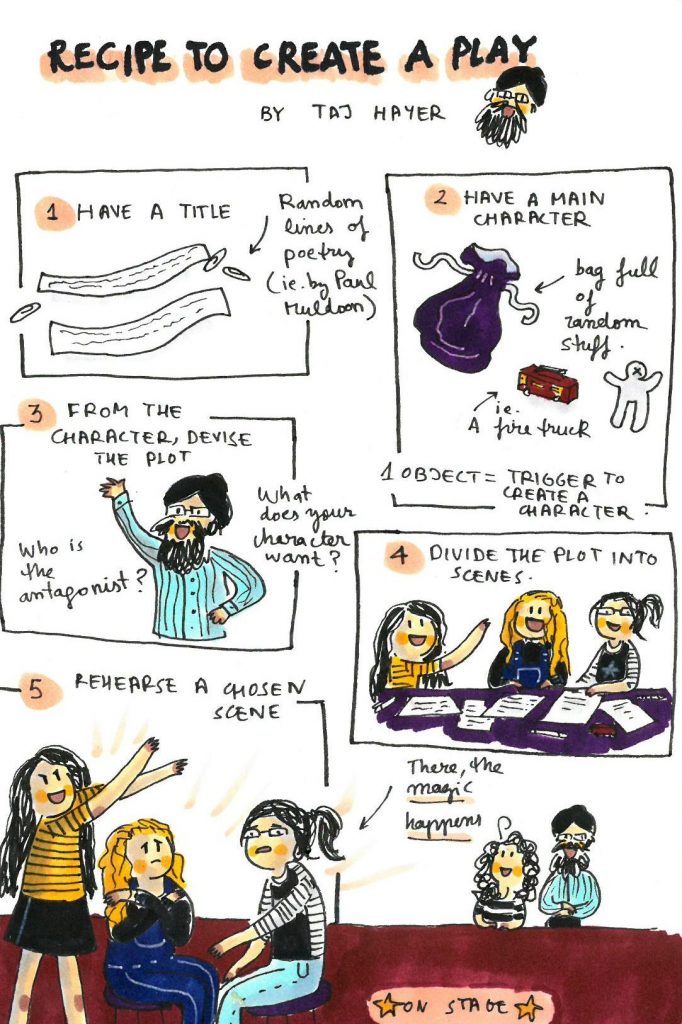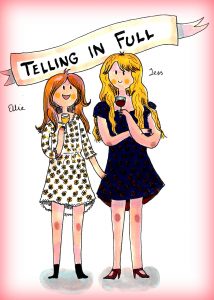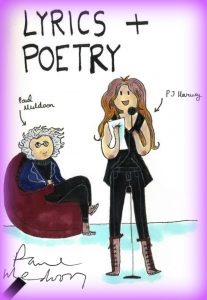Ines Gregori Labarta
Lancaster Words ‘With Muldoon’

Imagine you are inside a room. You have nothing but a notepad, a pen and a couple of Paul Muldoon’s poems. You’re not alone. There are other two people with you. You’ve never seen each other before. And now, you have to create. A Play. To rehearse it in front of a crowd of strangers in just two hours.
This is not an alternative plot for the Saw series – sorry if you were waiting for the gore – but the concept behind the drama workshop that was part of With Muldoon, Lancaster Word’s very first event.
The year-twelve students came to Lancaster University from Lancashire, Manchester and surrounding areas. They had been given a few Paul Muldoon’s poems – including Hedgehog and Wind and Tree. The students had diligently dissected them (in critical terms) and chose to take part in a variety of workshops: literary criticism, journalistic writing, drama and poetry. Apart from that, they had no idea what was going to happen.
Tajinder Hayer – our Creative Writing lecturer, expert on scriptwriting and author of the dystopian play Northcountry – started leading the drama workshop using several prompts (Muldoon’s random poem lines, a mysterious bag full of objects…) to trigger the students’ imagination.
I want to make something clear. Creating a play and rehearse a scene in front of a crowd in just two hours is not an easy task. Have you ever attempted to write a book, a play? Painted a scene, perhaps? If so, you probably know that one of the major curses in the artistic life is perfectionism. The more you become an expert, the more you’re aware of the one thousand bazillion mistakes you can make – and that can give you the chills, paralyse you, in fact. That’s why it’s so important to come to the creative process without any expectations, just ready to play. As Muldoon said, ‘I’m just the vehicle through which the poem expresses itself’.
These year-twelves had – perhaps without even realising – the same mindset. In less than fifteen minutes they had already bonded with each other – it turned out they all loved musicals. The students created a wide array of characters and situations: a child that is ignored by his parents, who are more interested in watching TV than playing with him; a family that rejects their eldest son because of his pursue of an artistic career instead of Medicine; a firefighter suffering from PTSD after seeing people die in a huge fire (this last one bears an uncanny resemblance with some recent events).
Taj moved the students from the backstage to the stage itself and encouraged them to wander and interact with each other and the space while they discussed the best way to bring characters and actions to life. Sometimes we restrict the creative process by
sitting around a table when, in fact, movement can free new ideas and insights. That is probably why so many writers love walking while they think of the next chapter, scene or poem.
The magic started the moment these students took the stage (now in front of the rest of the year-twelves, the teachers and the Lancaster Words team) to rehearse the scene. Right after, I heard some of the students talking about meeting each other to keep working on the play to submit it to some theatre festival in Manchester. These year-twelves came without knowing what to expect and left with a plot, characters, new friends and one realisation: they can make it happen.
Lancaster Words ‘Telling in Full’ exhibition

‘The idea of Telling In Full is that you miss things when you try to express something by using just one medium. Re-expressing it in a different medium can help you see the concept in full.’
Telling In Full is the exhibition created by Elinor Moore and Jessica Elleray, who have just graduated with a BA in Fine Arts and Creative Writing from Lancaster University. The exhibition, set at the Peter Scott Gallery, explores the connections between writing and visual art, that is, words and images.
As a writer and illustrator myself, I found the exhibition inspiring and original. I wish I could take all of you there and let you wander around paintings, sculptures, videos and performances who were conceived from pieces of writing. Sadly, I can’t recur to virtual reality for this post, so I thought I would bring you something else: a triptych of interviews with Elinor Moore, Jessica Elleray (Telling In Full’s curators) and Amy Sterly from the Sound Book Project that was performing at the exhibition on the 6th of July.
Elinor Moore, writer and fine artist
I’ve met Ellie for some years now. We’re both writers and joined the Lancaster University Hiking Club back in 2014. Walking together in the Lake District’s crags (where Ellie would help me through the most challenging bits) we discovered a common passion for eighteenth century literature, the Jacobites and Scotland. Ellie is a gifted painter and she recently obtained a prose award for her Creative Writing dissertation. I must confess I was amazed at how she managed to put together a large an ambitious project such as Telling In Full whilst pursuing the end of her degree. I’m sure the exhibition inspired many artists who want to try their skills across different mediums and narrate stories using both words and images.
Inés: It’s quite impressive to see that two students have organised this exhibition while finishing their degree. What was the best and the worst moment throughout all this process?
Ellie: Thank you! I’d say the best moment was the opening night, with all the artists coming and saying ‘thank you for showing my work in such an interesting exhibition’. The days running up to the exhibition and the day of the opening night were difficult, though. The walls of the gallery needed repairing: there were some holes, nails that had been left… We had to do a bit of painting and decorating before we actually started the installing and that put us behind the schedule. All the last minute stuff was very hectic. But then of course, it was followed by the highlight of the opening night.
I: Mixing writing and visual art is very interesting. As an artist yourself, how would you say these two things inform your work?
E: In the Fine Art degree we had to write art statements, this is, an explanation behind the project, the concept and why we used that particular media. This makes you think about so many different aspects. The idea of Telling in Full is that you miss things when you try to express something by using just one medium. Re-expressing it in a different medium can help you see the concept in full. Also, I’m quite a visual thinker, so in writing I always imagine the scenes as if they were films. I always play them and edit them in my head before I write them down. I feed a lot of sensorial details into my writing by doing this.
I: If a student comes to you wanting to do an exhibition and asking for advice, what would you tell her/him?
E: I’d tell them ambition is a good thing. If you have got passion and will power you will be surprised at what you can do. That’s key, so just keep trying and be confident in yourself.
Jessica Elleray, writer and fine artist
During the opening night in Telling In Full, I was introduced to Jess, the co-creator of the exhibition. During that night, there was a permanent flow of artists and audience walking around the space, watching the many different pieces. There was wine, a delicious buffet and an atmosphere of friendliness and curiosity. Jess was wandering around greeting the artists, helping people, selling catalogues and making sure everyone was comfortable. I was impressed at how professional and kind she was to everyone. And she’s not only a dedicated host but also a professional artist based in Silverdale that works primarily with copper. I suggest you check her eerie artwork inspired in the landscape of the Lake District. She has recently won a prize for her piece at the Fine Arts BA degree show.
Inés: Where do you see writing and visual art coming together?
Jess: In many respects, they are the same thing. Writing and creating artwork is a form of expressing yourself as a creator. As a writer and an artist they are very familiar to me, and they influence one another. That wouldn’t be the case for all artist or writers, though. That’s why we wanted ekphrasis to be the theme of this exhibition. Traditionally, ekphrasis has been all about writers writing about paintings. Turner wrote poems about his landscapes and so on. There isn’t much evidence of artists responding to literature, specially contemporary literature. So we were very interested in inviting artists to respond to this and explore the concept of ekphrasis fully. You could say ekphrasis is a kind of creative translation.
I: You write and create visual art… Do you have a favourite medium?
J: For me what connects them is an understanding of myself as a creative person. I have a fascination for people, places and the narratives that interlink them. My most recent work, a Yuaning Yan collection, is interested in cultural narratives and the stories of objects people carry with them when they travel.
I: After making this exhibition happen, if you could go back in time, what would you do differently?
J: I’d definitely encourage myself and say: ‘this is going to be horrendous and you’re going to be exhausted at the end but it’s going to be so worth it’. There was so much stuff me and Ellie got so fussy about that people probably didn’t noticed. For example, when you paint walls white you get obsessed with small patches and different kinds of white. It really bothered us. Also, I wish we had done more marketing, but we couldn’t, because the marketing window was at the same time that our degree show, which I was also organising. And yet many people turned up last night.
Amy Sterly, printmaker and sculptor, member of the Sound Book Project
During Telling In Full’s opening night, the Sound Book Project did a performance. When I entered the room, I saw a group of five people in front of a large table covered with books. They started creating rhythm by knocking them against the table and between each other. When one woman ripped a page, the writer inside me blushed in pure anger. ‘She’s hurting a book!’ I thought. Luckily it was not my own. And I have to say that, even being a person who can’t even stand the idea of throwing away a book or damaging it in any way, I soon forgot all this and got carried away with the music. I’m not a fan of atonal music, but the Sound Book Project oneiric tunes did take me to another realm. Many of the books they used had been altered to produce different sounds (for instance, there was a book that opened to reveal its pages arranged as an accordion’s bellows).
Inés: How did you come up with this idea?
Amy: It started when I did an exhibition of objects from my grandmother. One of the objects was a music box. I really liked the idea of making a catalogue of the exhibition but I also wanted to embed the music box in the book somehow. It made me think of book making and altering them to make music. It’s actually quite difficult to play something that doesn’t have a tune, you have to rely on rhythm. It’s very fascinating.
I: I loved the book / accordion you used… Do you compose the music pieces together?
A: Yes, we basically get all together and share ideas and play the books and see what happens. The very first time we played together we were all asking each other: ‘How do you play a book? What can you do with it?’
I: So, how much is it improvised?
A: What you listened to before it’s actually pretty written with just a little improvising.
I: How long have you been doing this?
A: Nearly two years now. An grant from the Arts Council of Wales helped us to develop the project last year.
Lancaster Words ‘PJ Harvey in Conversation with Paul Muldoon’

Tickets were sold out for this event with PJ Harvey and Paul Muldoon. More than half an hour before a crowd of enthusiastic fans stood in queue to enter the Nuffield Theatre at Lancaster University. Once inside, the atmospheric light and the reverent silence welcomed Lancaster University’s visiting professor Paul Muldoon and indie musician, songwriter and poet PJ Harvey.
It was obvious that these two artists had met before and liked each other. The conversation was fresh, intimate, but also revealing, as both discussed their creative processes and the (many) differences between writing a song and a poem.
PJ Harvey didn’t sing (that was already specified in the programme for this event) but she read aloud, along with Paul Muldoon, several poems and song lyrics (some of them hers, some of them pieces that have served as an inspiration through her artistic journey). I must confess that when she finished reading Something About a War by Stephen Sondheim and her own Down by the Water I had goosebumps in my arms. This let me thinking on the power of both poetry and song lyrics when read aloud. The human voice can be a extraordinary medium to express stories and emotions and it doesn’t need to be accompanied with music at all.
Listening to PJ Harvey and Paul Muldoon on the night of the 6th of July also inspired me to keep trying different mediums to express my stories. As it happened with the Telling In Full exhibition, I was shown once again that it’s possible for an artist to use (and indeed master) more than one medium, for instance lyric writing and poetry.
PJ Harvey explained how she stumbled upon poetry when working on her 2011 album Let England Shake. Writing the lyrics of this particular work was quite an challenge, so she decide to go to a local writer’s group to learn some poetry skills. This (which was supposed to be a punctual thing) turned up to be the start of a new passion. Today, PJ Harvey is also a recognised poet and her first anthology The Hollow of the Hand, published in 2015, has received outstanding reviews.
If you are wondering how to choose between two of your passions, be assured, there is no limit or timeframe. Just go all the way in with curiosity and wonder. As it happened to PJ Harvey, you may discover a latent talent you’d never thought was inside you all this time long!
